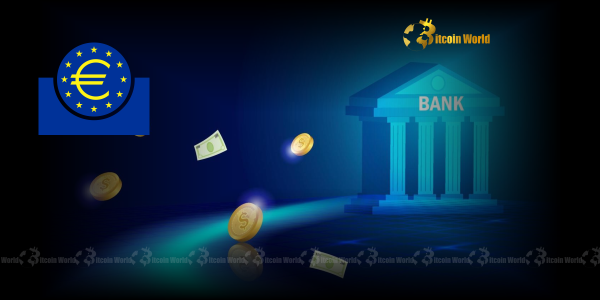ECB DLT Settlement: A Pioneering Step Towards Digital Finance Innovation
0
0
BitcoinWorld

ECB DLT Settlement: A Pioneering Step Towards Digital Finance Innovation
In a move that signals a significant shift in the world of traditional finance, the European Central Bank (ECB) has officially given its nod to a research project exploring the use of central bank funds for transactions settled on distributed ledger technology (DLT). This pivotal decision, as reported by CoinDesk, isn’t just a technical experiment; it’s a profound statement about the Eurosystem’s commitment to embracing the future of financial market infrastructures while upholding the highest standards of safety and efficiency. For anyone tracking the evolution of money and payments, this ECB DLT settlement initiative is nothing short of groundbreaking.
What Does the ECB DLT Settlement Project Entail?
The recent approval by the ECB’s Governing Council marks a crucial milestone in the journey towards modernizing Europe’s financial backbone. At its core, this research project aims to understand how central bank money can be utilized within a distributed ledger environment for settling transactions. Imagine a world where the speed and transparency of DLT meet the rock-solid stability and trust of central bank funds. That’s the vision the ECB is exploring.
- Purpose: To research the practical application of central bank funds for settling transactions using DLT.
- Motivation: Aligning with the Eurosystem’s dedication to fostering innovation without compromising on financial stability or operational efficiency.
- Context: Part of a broader effort by the ECB to explore how Distributed Ledger Technology can facilitate more efficient and secure payment systems.
This isn’t a hypothetical exercise; it’s a tangible step towards understanding the real-world implications and benefits of integrating cutting-edge technology into the very heart of the financial system. The focus here is on robust research, ensuring that any future implementation is both secure and beneficial for the wider economy.
Demystifying Distributed Ledger Technology (DLT) for Finance
You might have heard of DLT in the context of cryptocurrencies like Bitcoin, but its applications extend far beyond. At its simplest, Distributed Ledger Technology refers to a decentralized database managed by multiple participants, where transactions are recorded and verified across a network of computers. Unlike traditional databases, there’s no central authority. This inherent decentralization offers several compelling advantages:
- Transparency: All participants can see the ledger, enhancing trust and reducing disputes.
- Immutability: Once a transaction is recorded, it’s incredibly difficult to alter, ensuring data integrity.
- Efficiency: Transactions can be processed faster, often in near real-time, by eliminating intermediaries.
- Security: The distributed nature makes the system highly resilient to attacks and single points of failure.
For financial market infrastructures, these characteristics are transformative. They promise faster settlement times, reduced operational costs, and enhanced security, ultimately making the financial system more robust and responsive. The ECB’s exploration of DLT underscores its potential to revolutionize how payments and settlements are conducted at a fundamental level.
Is This a Precursor to Central Bank Digital Currencies (CBDCs)?
While the ECB’s DLT settlement project is distinct from a full-fledged launch of a Central Bank Digital Currency (CBDC), it’s undeniably a significant step in that direction. CBDCs, like the proposed Digital Euro, are digital forms of a country’s fiat currency, issued and backed by the central bank. They aim to combine the innovation of digital payments with the safety and trust of central bank money.
The research into DLT for wholesale settlements (transactions between financial institutions) provides invaluable insights that could inform the design and implementation of a future Digital Euro. Key areas of overlap include:
- Technological Foundation: DLT is a primary candidate for the underlying technology of many CBDC designs.
- Settlement Efficiency: Both DLT settlement projects and CBDCs aim to improve the speed and finality of payments.
- Interoperability: Understanding how DLT-based systems interact with existing financial infrastructure is crucial for any future digital currency.
The ECB has been actively exploring the concept of a Digital Euro for retail use, and this wholesale DLT project complements those efforts, creating a comprehensive research agenda for the future of digital money in the Eurozone.
Why Does Financial Innovation Matter for Europe?
The pursuit of Financial Innovation is not merely about adopting new technologies; it’s about strengthening economic resilience, fostering competitiveness, and ensuring that Europe remains at the forefront of the global financial landscape. For the Eurozone, embracing DLT and exploring its applications can lead to several tangible benefits:
Enhanced Efficiency and Speed: Current settlement systems can be complex and time-consuming. DLT offers the potential for instant, atomic settlements, reducing counterparty risk and freeing up capital. This means faster transactions for businesses and individuals, driving economic activity.
Increased Security and Resilience: The distributed nature of DLT makes it inherently more secure and less prone to single points of failure than centralized systems. This robustness is critical for safeguarding financial stability in an increasingly digital world.
Reduced Costs: By streamlining processes and reducing the need for intermediaries, DLT can significantly lower the operational costs associated with financial transactions, benefiting both financial institutions and, indirectly, their customers.
New Opportunities: A DLT-enabled financial infrastructure could unlock new business models and services, encouraging further innovation within the European financial sector. This could include new types of financial products, improved cross-border payments, and more efficient asset management.
What Challenges Lie Ahead for the Digital Euro and DLT Integration?
While the potential benefits are clear, the path to fully integrating Distributed Ledger Technology and potentially launching a Digital Euro is not without its hurdles. The ECB’s research project is precisely designed to identify and address these challenges proactively:
- Regulatory and Legal Frameworks: Existing laws and regulations were not designed for DLT. New frameworks will be needed to ensure legal certainty, consumer protection, and financial stability.
- Interoperability: How will DLT-based systems seamlessly interact with legacy financial systems and other DLT networks? Achieving broad interoperability is key for widespread adoption.
- Privacy and Data Protection: While DLT offers transparency, ensuring user privacy in a digital currency or settlement system is paramount, especially in a region with strong data protection laws like Europe.
- Cybersecurity Risks: Despite DLT’s inherent security, new attack vectors can emerge. Robust cybersecurity measures will be crucial to protect against digital threats.
- Scalability: Can DLT systems handle the massive volume of transactions required for a national or supranational currency or large-scale wholesale settlements?
- Public Acceptance and Education: For a retail Digital Euro, widespread public understanding and acceptance will be vital.
The ECB’s cautious yet determined approach, starting with research and pilot projects, is a pragmatic way to navigate these complexities, ensuring that any future steps are well-informed and robust.
A Glimpse into Europe’s Digital Financial Future
The ECB’s approval of this DLT settlement project is more than just a headline; it’s a powerful signal of Europe’s commitment to leading the charge in financial innovation. By actively exploring how central bank funds can operate on distributed ledgers, the Eurosystem is laying the groundwork for a more efficient, secure, and resilient financial future. This pioneering step is a testament to the proactive stance taken by the ECB in adapting to the digital age, ensuring that the European financial landscape remains robust and competitive. As the research progresses, the insights gained will undoubtedly shape the evolution of both wholesale settlements and the potential development of a Digital Euro, promising a transformative impact on how we perceive and use money.
To learn more about the latest crypto market trends, explore our article on key developments shaping Central Bank Digital Currencies institutional adoption.
This post ECB DLT Settlement: A Pioneering Step Towards Digital Finance Innovation first appeared on BitcoinWorld and is written by Editorial Team
0
0
 Manage all your crypto, NFT and DeFi from one place
Manage all your crypto, NFT and DeFi from one placeSecurely connect the portfolio you’re using to start.

